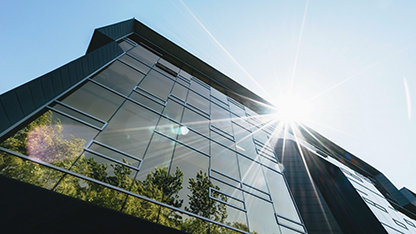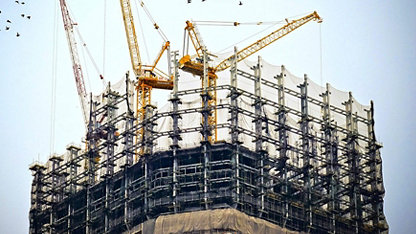Bamboo’s prodigious growth rate makes the grass a carbon-hungry plant – and one of the world’s most efficient carbon storage systems.
The Moso species native to China stores up to 250 tonnes of carbon per hectare – comparable to trees, but much more cost effective. Bamboo is also a pioneer plant, meaning it can grow in places no other plants can. This makes it a valuable tool for re-stabilising eroded landscapes, and also means that it does not have to compete with food crops for suitable land. And it is strong. So strong that some researchers believe bamboo composites could one day replace steel as the structural reinforcement material of choice in buildings – a shift that would drastically reduce the carbon debt of the construction industry.
“The question of resources is, next to the question of energy, the most important one of our time,” says Dirk E. Hebel, an architect and professor of sustainable construction at the Karlsruhe Institute of Technology in Germany. “We need to shift from a mining ideology to a kind of cultivating ideology – cultivating in the sense that we are moving towards the idea of growing our own construction materials.
“We need to shift from a mining ideology to a kind of cultivating ideology – cultivating in the sense that we are moving towards the idea of growing our own construction materials.”
Dirk Hebel
Karlsruhe Institute of Technology
“Bamboo has a natural capacity to take high-tensile force,” he continues. “Steel, used as a reinforcement, is mainly placed into concrete to take care of tensile forces, so it was a logical step to ask ‘can we make a material out of bamboo that could replace steel as a reinforcement element in concrete?’” The answer seems to be, yes.
Hebel and his fellow researchers have developed a composite that combines the plant’s fibres with a resin that allows the material to be heat-compressed into various shapes, as well as preventing it from degrading. The fibre is extracted from a large number of bamboo stems – or culms – mainly from species found in Ethiopia and Indonesia, and combined to create an average strength across the product, dealing with some of the issues of consistency that occur when using natural fibres.
“We are just at the start of this research,” says Hebel. “This is a natural material and that means new standards and new ideas about how to calculate the engineering of such materials, how to calculate the geometry of these shapes, will need to be developed. You cannot simply recreate the same shape as the steel. Everything needs to be revisited, recalculated, re-engineered. And that takes time.”
Bamboo has a long tradition of being used as a structural material where it grows natively, and is still used as scaffolding and for housing in areas of Asia, Africa and South America. Only a few dozen species are suitable for construction, with Moso, Asper and Guadua among the most common.
Now, specialist bamboo architecture companies such as Ibuku in Bali are pioneering new, ambitious building forms, and well-known architects like Vietnam’s Vo Trong Nghia are helping to increase its appeal. Nghia has described bamboo as “the green steel of the 21st century”, and has completed many projects using the material, including the Vietnam pavilion for the Milan Expo in 2015. The Chinese architect Yichen Lu, founder of New York-based Studio Link-Arc, designed the Chinese pavilion for the same event, with an undulating sun-screen of bamboo over the roof.
Lu believes that Eastern and Western approaches need to be combined to fully realise the real potential of the material: “In China there are lots of new manufacturers producing bamboo for flooring, for example. But in my work, bamboo would be used very similarly to ‘glulam’ (glue-laminated wood) material, and the main technology for glulam is based in Europe and the US, not China.”
In its basic form, bamboo does not last long and rots quickly when exposed to damp, is easily sun-damaged and prone to attacks from insects. If a structure is designed so that parts can be easily replaced and is located where suitable species grow abundantly, regular replenishment is not much of an issue – bamboo is cheap and it is also easy to dispose of.
“Recent advancements in materials engineering have made bamboo a viable and low-cost material for creating cities.”
Earl Patrick Forlales
Cities for our Future winner
But larger species do not grow well in northern climates, and in Western countries bamboo is mainly relegated to interiors in the form of heat- and chemical-treated laminated versions. In Europe, bamboo is becoming an increasingly familiar material in use for flooring, kitchen surfaces, doors and chopping boards.
“To instigate building with bamboo efficiently and at scale in the UK would require a significant culture shift within the industry,” says architect Maria Smith, co-founder of London practice Interrobang and part of Webb Yates Engineers. “We are enthusiastic about the possibilities of bamboo. However, in addition to the industry’s general lack of familiarity, there are several key barriers to be overcome. UK design codes and regulations are not set up for non-standard materials.”
Simon Corbey MRICS, associate director at the UK’s Alliance for Sustainable Building Products, agrees. He has seen a slow upswing of interest in natural materials that have the potential to reduce construction’s carbon footprint, but rigid performance measures such as the thermal conduction of insulation materials are preventing faster take-up.
“People are always risk averse – they tend to want to use things they know about,” he says. “Bamboo is going to be a slow burn. If I were considering materials to introduce into UK construction, I would be looking at those that we grow here. As an example, we’re looking at rapeseed fibre as a potential product for insulation.”
The industrial framework for manufacturing bamboo products and materials is still in its infancy. China is currently leading the way in laminate products such as flooring, but if bamboo becomes a structural material then new industrial systems and standards will need to be designed, almost from scratch.
David Trujillo, senior lecturer in civil engineering at Coventry University and chair of the Bamboo Construction Task Force for the International Network for Bamboo and Rattan (Inbar), thinks there is still a long way to go. “It’s a long and expensive process to get things standardised,” he explains. “It’s a sort of chicken and egg situation – we won’t consume it until it’s standardised, to standardise it you need money, to have money you need a product that is commercially successful.
“Bamboo has the strength of hardwood but it has quite limited natural durability,” Trujillo adds. “Although it’s quite a sustainable material, it needs to be transformed into an engineered product, which may be why there still isn’t a product that is commercially competitive.”
However, one of the remaining arguments against investing in the development of bamboo as a zero-carbon construction product for the Western market has recently been challenged. A study by Delft University – with Moso Bamboo Products and Inbar – in the Netherlands, showed that items made from imported, engineered bamboo could not only be carbon neutral, but carbon negative, too. The one caveat to this, is that the emissions from the production and shipping processes need to be factored into the resultant carbon footprint of the product’s life-cycle.
Despite having been used as a building material for thousands of years, it seems that bamboo is only at the early stages of its real growth spurt as a material of the future for the construction industry.












